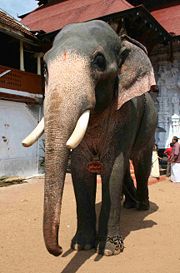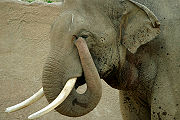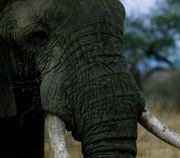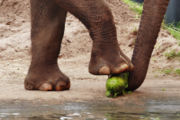Elephant
2008/9 Schools Wikipedia Selection. Related subjects: Mammals
| Elephant | ||||||||||||||
|---|---|---|---|---|---|---|---|---|---|---|---|---|---|---|
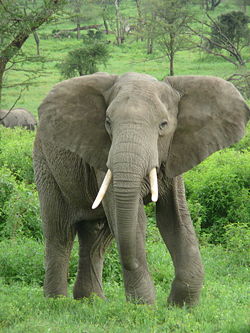 An African Bush Elephant near the border of the Serengeti and Ngorongoro Conservation Area in Tanzania.
|
||||||||||||||
| Scientific classification | ||||||||||||||
|
||||||||||||||
| Subfamilia | ||||||||||||||
|
The elephant ( family: Elephantidae) is a large land mammal in the order Proboscidea. There are two living species: the African Elephant and the Asian Elephant (also known as the Indian Elephant). Other species have become extinct since the last ice age, the Mammoths being the best-known of these. They were once classified along with other thick skinned animals in a now invalid order, Pachydermata.
Elephants are the largest land animals. The elephant's gestation period is 22 months, the longest of any land animal. At birth it is common for an elephant calf to weigh 120 kilograms (260 lb). An elephant may live as long as 70 years, sometimes longer. The largest elephant ever recorded was shot in Angola in 1956. This male weighed about 12,000 kilograms (26,000 lb), with a shoulder height of 4.2 metres (14 ft), a metre (yard) taller than the average male African elephant. The smallest elephants, about the size of a calf or a large pig, were a prehistoric species that lived on the island of Crete during the Pleistocene epoch.
The elephant has been an icon for humanity for thousands of years, appearing in cultures across Europe, Asia, Africa and the Americas. They are symbols of wisdom in Asian cultures and are famed for their memory and high intelligence, where they are thought to be on par with cetaceans and hominids. Aristotle once said the elephant was "the beast which passeth all others in wit and mind". The word "elephant" has its origins in the Greek ἐλέφας, meaning "ivory" or "elephant".
Healthy adult elephants have no natural predators, although lions may take calves or weak individuals.. They are, however, increasingly threatened by human intrusion and poaching. Once numbering in the millions, the African elephant population has dwindled to between 470,000 and 690,000 individuals. The elephant is now a protected species worldwide, with restrictions in place on capture, domestic use, and trade in products such as ivory.
Taxonomy and evolution
The African Elephant genus contains two (or, arguably, three) living species; whereas, the Asian Elephant species is the only surviving member of the Asian Elephant genus, but can be divided into four subspecies.

Although the fossil evidence is uncertain, scientists discovered genetic evidence that the elephant family shares distant ancestry with the sirenians (sea cows) and the hyraxes through gene comparisons. In the distant past, members of the hyrax family grew to large sizes, and it seems likely that the common ancestor of all three modern families was some kind of amphibious hyracoid. One theory suggests that these animals spent most of their time under water, using their trunks like snorkels for breathing. Modern elephants have retained this ability and are known to swim in that manner for up to 6 hours and 50 km (30 miles).
In the past, there was a much wider variety of elephant genera, including the mammoths, stegodons and deinotheria. There was also a much wider variety of species.
African Elephant
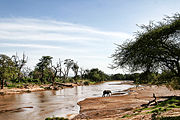
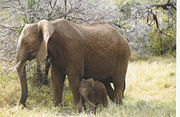
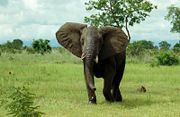
The Elephants of the genus Loxodonta, known collectively as African elephants, are currently found in 37 countries in Africa.
African elephants are distinguished from Asian elephants in several ways, the most noticeable being their ears which are much larger. The African elephant is typically larger than the Asian elephant and has a concave back. Both African males and females have external tusks and are usually less hairy than their Asian cousins.
African elephants have traditionally been classified as a single species comprising two distinct subspecies, namely the savanna elephant (Loxodonta africana africana) and the forest elephant (Loxodonta africana cyclotis), but recent DNA analysis suggests that these may actually constitute distinct species. This split is not universally accepted by experts and a third species of African elephant has also been proposed.
This reclassification has important implications for conservation, because it means that where previously it was assumed that a single and endangered species comprised two small populations, if in reality these are two separate species, then as a consequence, both could be more gravely endangered than a more numerous and wide-ranging single species might have been. There is also a potential danger in that, if the forest elephant is not explicitly listed as an endangered species, poachers and smugglers might be able to evade the law forbidding trade in endangered animals and their body parts.
The Forest elephant and the Savanna elephant can also hybridise – that is, breed together – successfully, though their preferences for different terrains reduce such opportunities. As the African elephant has only recently been recognized to comprise two separate species, groups of captive elephants have not been comprehensively classified and some could well be hybrids.
Under the new two species classification, Loxodonta africana refers specifically to the Savanna Elephant, the largest of all elephants. In fact, it is the largest land animal in the world, standing 3.1 metres (10 ft) to 4 metres (13 ft) at the shoulder and weighing approximately 7,000 kilograms (15,000 lb). The average male stands about 3 metres (10 ft) tall at the shoulder and weighs about 5500 (12000 lb) to 6,000 kilograms (13,000 lb), the female being much smaller. Most often, Savanna Elephants are found in open grasslands, marshes, and lakeshores. They range over much of the savanna zone south of the Sahara.
The other putative species, the Forest Elephant (Loxodonta cyclotis), is usually smaller and rounder, and its tusks thinner and straighter compared with the Savanna Elephant. The Forest Elephant can weigh up to 4,500 kilograms (9,900 lb) and stand about 3 metres (10 ft) tall. Much less is known about these animals than their savanna cousins, because environmental and political obstacles make them difficult to study. Normally, they inhabit the dense African rain forests of central and western Africa, although occasionally they roam the edges of forests, thus overlapping the Savanna elephant territories and hybridizing. In 1979, Iain Douglas-Hamilton estimated the continental population of African elephants at around 1.3 million animals. This estimate is controversial and is believed to be a gross overestimate, but it is very widely cited and has become a de facto baseline that continues to be incorrectly used to quantify downward population trends in the species. Through the 1980s, Loxodonta received worldwide attention due to the dwindling numbers of major populations in East Africa, largely as a result of poaching. Today, according to IUCN’s African Elephant Status Report 2007 there are approximately between 470,000 and 690,000 African elephants in the wild. Although this estimate only covers about half of the total elephant range, experts do not believe the true figure to be much higher, as it is unlikely that large populations remain to be discovered. By far the largest populations are now found in Southern and Eastern Africa, which together account for the majority of the continental population. According to a recent analysis by IUCN experts, most major populations in Eastern and Southern Africa are stable or have been steadily increasing since the mid-1990s, at an average rate of 4.5% per annum.
Elephant populations in West Africa, on the other hand, are generally small and fragmented, and only account for a small proportion of the continental total. Much uncertainty remains as to the size of the elephant population in Central Africa, where the prevalence of forest makes population surveys difficult, but poaching for ivory and bushmeat is believed to be intense through much of the region. South Africa elephant population more than doubled, rising from from 8,000 to over 20,000, in the thirteen years after a 1995 ban on killing the animals. The ban was lifted in February 2008, sparking controversy among environmental groups.
Asian Elephant
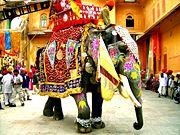
The Asian elephant, Elephas maximus, is smaller than the African. It has smaller ears, and typically, only the males have large external tusks.
The world population of Asian elephants – also called Indian Elephants – is estimated to be around 60,000, about a tenth of the number of African elephants. More precisely, it is estimated that there are between 38,000 and 53,000 wild elephants and between 14,500 and 15,300 domesticated elephants in Asia with perhaps another 1,000 scattered around zoos in the rest of the world. The Asian elephants' decline has possibly been more gradual than the African and caused primarily by poaching and habitat destruction by human encroachment.
Several subspecies of Elephas maximus have been identified, using morphometric data and molecular markers. Elephas maximus maximus ( Sri Lankan Elephant) is found only on the island of Sri Lanka. It is the largest of the Asians. There is an estimated 3,000–4,500 members of this subspecies left today in the wild, although no accurate census has been carried out recently. Large males can weigh upward to 5,400 kg (12,000 lb) and stand over 3.4 m (11 ft) tall. Sri Lankan males have very large cranial bulges, and both sexes have more areas of depigmentation than other Asians. Typically, their ears, face, trunk, and belly have large concentrations of pink-speckled skin. There is an orphanage for elephants in Pinnawala Sri Lanka, which plays a large role in protecting the Sri Lankan Elephant from extinction.
Elephas maximus indicus ( Indian Elephant) makes up the bulk of the Asian elephant population. Numbering approximately 36,000, these elephants are lighther grey in colour, with depigmentation only on the ears and trunk. Large males will ordinarily weigh only about 5,000 kg (11,000 lb), but are as tall as the Sri Lankan. The mainland Asian can be found in 11 Asian countries, from India to Indonesia. They prefer forested areas and transitional zones, between forests and grasslands, where greater food variety is available.
The smallest of all the elephants is the Sumatran Elephant, Elephas maximus sumatranus. Population estimates for this group range from 2,100 to 3,000 individuals. It is very light grey in colour and has less depigmentation than the other Asians, with pink spots only on the ears. Mature Sumatrans will usually only measure 1.7–2.6 m (5.6–8.5 ft) at the shoulder and weigh less than 3,000 kg (6,600 lb). It is considerably smaller than its other Asian (and African) cousins and exists only on the island of Sumatra, usually in forested regions and partially wooded habitats.
In 2003, a further subspecies was identified on Borneo. Named the Borneo pygmy elephant, it is smaller and tamer than any other Asian elephants. It also has relatively larger ears, longer tail and straighter tusks.
Physical characteristics
Trunk
The proboscis, or trunk, is a fusion of the nose and upper lip, elongated and specialized to become the elephant's most important and versatile appendage. African elephants are equipped with two fingerlike projections at the tip of their trunk, while Asians have only one. According to biologists, the elephant's trunk may have over forty thousand individual muscles in it, making it sensitive enough to pick up a single blade of grass, yet strong enough to rip the branches off a tree. Some sources indicate that the correct number of muscles in an elephant's trunk is closer to one hundred thousand.
Most herbivores (plant eaters, like the elephant) possess teeth adapted for cutting and tearing off plant materials. However, except for the very young or infirm, elephants always use their trunks to tear up their food and then place it in their mouth. They will graze on grass or reach up into trees to grasp leaves, fruit, or entire branches. If the desired food item is too high up, the elephant will wrap its trunk around the tree or branch and shake its food loose or sometimes simply knock the tree down altogether.
The trunk is also used for drinking. Elephants suck water up into the trunk (up to fifteen quarts or fourteen litres at a time) and then blow it into their mouth. Elephants also inhale water to spray on their body during bathing. On top of this watery coating, the animal will then spray dirt and mud, which act as a protective sunscreen. When swimming, the trunk makes an excellent snorkel.
This appendage also plays a key role in many social interactions. Familiar elephants will greet each other by entwining their trunks, much like a handshake. They also use them while play-wrestling, caressing during courtship and mother / child interactions, and for dominance displays – a raised trunk can be a warning or threat, while a lowered trunk can be a sign of submission. Elephants can defend themselves very well by flailing their trunk at unwanted intruders or by grasping and flinging them.
An elephant also relies on its trunk for its highly developed sense of smell. Raising the trunk up in the air and swivelling it from side to side, like a periscope, it can determine the location of friends, enemies, and food sources.
Tusks
The tusks of an elephant are its second upper incisors. Tusks grow continuously; an adult male's tusks will grow about 18 cm (7 in) a year. Tusks are used to dig for water, salt, and roots; to debark trees, to eat the bark; to dig into baobab trees to get at the pulp inside; and to move trees and branches when clearing a path. In addition, they are used for marking trees to establish territory and occasionally as weapons.
Like humans who are typically right- or left-handed, elephants are usually right- or left-tusked. The dominant tusk, called the master tusk, is generally shorter and more rounded at the tip from wear. Both male and female African elephants have large tusks that can reach over 3 m (10 ft) in length and weigh over 90 kg (200 lb). In the Asian species, only the males have large tusks. Female Asians have tusks which are very small or absent altogether. Asian males can have tusks as long as the much larger Africans, but they are usually much slimmer and lighter; the heaviest recorded is 39 kg (86 lb). The tusk of both species is mostly made of calcium phosphate in the form of apatite. As a piece of living tissue, it is relatively soft (compared with other minerals such as rock), and the tusk, also known as ivory, is strongly favoured by artists for its carvability. The desire for elephant ivory has been one of the major factors in the reduction of the world's elephant population.
Some extinct relatives of elephants had tusks in their lower jaws in addition to their upper jaws, such as Gomphotherium, or only in their lower jaws, such as Deinotherium.
Teeth
Elephants' teeth are very different from those of most other mammals. Over their lives they usually have 28 teeth. These are:
- The two upper second incisors: these are the tusks.
- The milk precursors of the tusks.
- 12 premolars, 3 in each side of each jaw.
- 12 molars, 3 in each side of each jaw.
This gives elephants a dental formula of:
| 1.0.3.3 |
| 0.0.3.3 |
Unlike most mammals, which grow baby teeth and then replace them with a permanent set of adult teeth, elephants have cycles of tooth rotation throughout their entire life. After one year the tusks are permanent, but the molars are replaced six times in an average elephant's lifetime. The teeth do not emerge from the jaws vertically like with human teeth. Instead, they have a horizontal progression, like a conveyor belt. New teeth grow in at the back of the mouth, pushing older teeth toward the front, where they wear down with use and the remains fall out. When an elephant becomes very old, the last set of teeth is worn to stumps, and it must rely on softer foods to chew. Very elderly elephants often spend their last years exclusively in marshy areas where they can feed on soft wet grasses. Eventually, when the last teeth fall out, the elephant will be unable to eat and will die of starvation. Were it not for tooth wearout, their metabolism would allow them to live much longer. Rupert Sheldrake has proposed this as an explanation for the elephant graveyards. However, as more habitat is destroyed, the elephants' living space becomes smaller and smaller; the elderly no longer have the opportunity to roam in search of more appropriate food and will, consequently, die of starvation at an earlier age.
Tusks in the lower jaw are also second incisors. These grew out large in Deinotherium and some mastodons, but in modern elephants they disappear early without erupting.
Skin
Elephants are colloquially called pachyderms (from their original scientific classification), which means thick-skinned animals. An elephant's skin is extremely tough around most parts of its body and measures about 2.5 centimetres (1.0 in) thick. However, the skin around the mouth and inside of the ear is paper-thin. Normally, the skin of an Asian is covered with more hair than its African counterpart. This is most noticeable in the young. Asian calves are usually covered with a thick coat of brownish red fuzz. As they get older, this hair darkens and becomes more sparse, but it will always remain on their heads and tails.
The species of elephants are typically greyish in colour, but the Africans very often appear brown or reddish from wallowing in mud holes of coloured soil. Wallowing is an important behaviour in elephant society. Not only is it important for socialization, but the mud acts as a sunscreen, protecting their skin from harsh ultraviolet radiation. Although tough, an elephant's skin is very sensitive. Without regular mud baths to protect it from burning, as well as from insect bites and moisture loss, an elephant's skin would suffer serious damage. After bathing, the elephant will usually use its trunk to blow dirt on its body to help dry and bake on its new protective coat. As elephants are limited to smaller and smaller areas, there is less water available, and local herds will often come too close over the right to use these limited resources.
Wallowing also aids the skin in regulating body temperatures. Elephants have difficulty in releasing heat through the skin because, in proportion to their body size, they have very little of it. The ratio of an elephant's mass to the surface area of its skin is many times that of a human. Elephants have even been observed lifting up their legs to expose the soles of their feet, presumably in an effort to expose more skin to the air. Since wild elephants live in very hot climates, they must have other means of getting rid of excess heat.
Legs and feet
An elephant's legs are great straight pillars, as they must be to support its bulk. The elephant needs less muscular power to stand because of its straight legs and large pad-like feet. For this reason an elephant can stand for very long periods of time without tiring. In fact, African elephants rarely lie down unless they are sick or wounded. Indian elephants, in contrast, lie down frequently.
The feet of an elephant are nearly round. African elephants have three nails on each hind foot, and four on each front foot. Indian elephants have four nails on each hind foot and five on each front foot. Beneath the bones of the foot is a tough, gelatinous material that acts as a cushion or shock absorber. Under the elephant's weight the foot swells, but it gets smaller when the weight is removed. An elephant can sink deep into mud, but can pull its legs out readily because its feet become smaller when they are lifted.
An elephant is a good swimmer, but it can neither trot, jump, nor gallop. It does have two gaits: a walk; and a faster gait that is similar to running.
In walking, the legs act as pendulums, with the hips and shoulders rising and falling while the foot is planted on the ground. With no "aerial phase", the faster gait does not meet all the criteria of running, as elephants always have at least one foot on the ground. However, an elephant moving fast uses its legs much like a running animal, with the hips and shoulders falling and then rising while the feet are on the ground. In this gait, an elephant will have three feet off the ground at one time. As both of the hind feet and both of the front feet are off the ground at the same time, this gait has been likened to the hind legs and the front legs taking turns running.
Although they start this "run" at only 8 km/h, elephants can reach speeds up to 25 km/h, all the while using the same gait. At this speed, most other four-legged creatures are well into a gallop, even accounting for leg length. Spring-like kinetics could explain the difference between the motion of elephants and other animals.
Ears
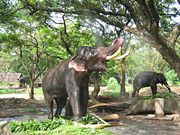
The large flapping ears of an elephant are also very important for temperature regulation. Elephant ears are made of a very thin layer of skin stretched over cartilage and a rich network of blood vessels. On hot days, elephants will flap their ears constantly, creating a slight breeze. This breeze cools the surface blood vessels, and then the cooler blood gets circulated to the rest of the animal's body. The hot blood entering the ears can be cooled as much as ten degrees Fahrenheit before returning to the body. Differences in the ear sizes of African and Asian elephants can be explained, in part, by their geographical distribution. Africans originated and stayed near the equator, where it is warmer. Therefore, they have bigger ears. Asians live farther north, in slightly cooler climates, and thus have smaller ears.
The ears are also used in certain displays of aggression and during the males' mating period. If an elephant wants to intimidate a predator or rival, it will spread its ears out wide to make itself look more massive and imposing. During the breeding season, males give off an odour from a gland located behind their eyes. Joyce Poole, a well-known elephant researcher, has theorized that the males will fan their ears in an effort to help propel this "elephant cologne" great distances.
Biology and behaviour
Social behaviour
Elephants live in a structured social order. The social lives of male and female elephants are very different. The females spend their entire lives in tightly knit family groups made up of mothers, daughters, sisters, and aunts. These groups are led by the eldest female, or matriarch. Adult males, on the other hand, live mostly solitary lives.
The social circle of the female elephant does not end with the small family unit. In addition to encountering the local males that live on the fringes of one or more groups, the female's life also involves interaction with other families, clans, and subpopulations. Most immediate family groups range from five to fifteen adults, as well as a number of immature males and females. When a group gets too big, a few of the elder daughters will break off and form their own small group. They remain very aware of which local herds are relatives and which are not.
The life of the adult male is very different. As he gets older, he begins to spend more time at the edge of the herd, gradually going off on his own for hours or days at a time. Eventually, days become weeks, and somewhere around the age of fourteen, the mature male, or bull, sets out from his natal group for good. While males do live primarily solitary lives, they will occasionally form loose associations with other males. These groups are called bachelor herds. The males spend much more time than the females fighting for dominance with each other. Only the most dominant males will be permitted to breed with cycling females. The less dominant ones must wait their turn. It is usually the older bulls, forty to fifty years old, that do most of the breeding.
The dominance battles between males can look very fierce, but typically they inflict very little injury. Most of the bouts are in the form of aggressive displays and bluffs. Ordinarily, the smaller, younger, and less confident animal will back off before any real damage can be done. However, during the breeding season, the battles can get extremely aggressive, and the occasional elephant is injured. During this season, known as musth, a bull will fight with almost any other male it encounters, and it will spend most of its time hovering around the female herds, trying to find a receptive mate.
Males will sometime also engage in same-sex bonding and mounting. Such encounters are often associated with affectionate interactions, such as kissing, trunk intertwining, and placing trunks in each other's mouths.Unlike heterosexual relations however, which are always of a fleeting nature, those between males result in a "companionship", consisting of an older individual and one or two younger, attendant males.
Rogue elephant is a term for a lone, violently aggressive wild elephant, separated from the rest of the herd. It is a calque of the Sinhala term hora aliya. Its introduction to English has been attributed by the Oxford English Dictionary to Sir James Emerson Tennent, but this usage may have been pre-dated by William Sirr.
Intelligence

With a mass just over 5 kg (11 lb), elephant brains are larger than those of any land animal, and although the largest whales have body masses twentyfold those of a typical elephant, whale brains are barely twice the mass of an elephant's. A wide variety of behaviours, including those associated with grief, making music, art, altruism, allomothering, play, use of tools, compassion and self-awareness evidence a highly intelligent species on par with cetaceans and primates.
The largest areas in elephant brain are those responsible for hearing, smell and movement coordination, and a large portion of the brain has to do with trunk management and sensitivity.
Senses
Elephants have well innervated trunks, and an exceptional sense of hearing and smell. The hearing receptors reside not only in ears, but also in trunks that are sensitive to vibrations, and most significantly feet, which have special receptors for low frequency sound and are exceptionally well innervated. It is believed that sound communication between elephants on large distances, through the ground, is important in their social lives, and elephants are observed listening by putting trunks on the ground and carefully moving their very sensitive feet.
Self-awareness
Mirror self recognition is a test of self awareness and cognition used in animal studies. A mirror was provided and visible marks were made on the elephant. The elephants investigated these marks, that were visible only via the mirror. The tests also included non-visible marks to rule out the possibility of their using other senses to detect these marks. This shows that elephants recognize the fact that the image in the mirror is their own self and such abilities are considered the basis for empathy, altruism and higher social interactions. This ability had earlier only been demonstrated in humans, apes and dolphins.
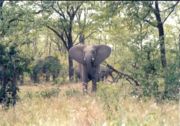
Communication
Elephants communicate over long distances by producing and receiving low-frequency sound (infrasound), a sub-sonic rumbling, which can travel through the ground farther than sound travels through the air. This can be felt by the sensitive skin of an elephant's feet and trunk, which pick up the resonant vibrations much as the flat skin on the head of a drum. To listen attentively, every member of the herd will lift one foreleg from the ground, and face the source of the sound, or often lay its trunk on the ground. The lifting presumably increases the ground contact and sensitivity of the remaining legs. This ability is thought also to aid their navigation by use of external sources of infrasound. Discovery of this new aspect of elephant social communication and perception came with breakthroughs in audio technology, which can pick up frequencies outside the range of the human ear. Pioneering research in elephant infrasound communication was done by Katy Payne, of the Elephant Listening Project, and is detailed in her book Silent Thunder. Though this research is still in its infancy, it is helping to solve many mysteries, such as how elephants can find distant potential mates, and how social groups are able to coordinate their movements over extensive range.
Diet
Elephants are herbivores, spending 16 hours a day collecting plant food. Their diet is at least 50% grasses, supplemented with leaves, bamboo, twigs, bark, roots, and small amounts of fruits, seeds and flowers. Because elephants only digest 40% of what they eat, they have to make up for their digestive system's lack of efficiency in volume. An adult elephant can consume 140–270 kg (300–600 lb) of food a day. 60% of that food leaves the elephant's body undigested.
Reproduction and life cycle
Elephant calves
Elephant social life revolves around breeding and raising of the calves. A female will usually be ready to breed around the age of thirteen, at which time she will seek out the most attractive male to mate with. Females are generally attracted to bigger, stronger, and, most importantly, older males. Such a reproductive strategy tends to increase their offspring's chances of survival.
After a twenty-two-month pregnancy, the mother will give birth to a calf that will weigh about 113 kg (250 lb) and stand over 76 cm (2.5 ft) tall. Elephants have a very long childhood. They are born with fewer survival instincts than many other animals. Instead, they must rely on their elders to teach them the things they need to know. Today, however, the pressures humans have put on the wild elephant populations, from poaching to habitat destruction, mean that the elderly often die at a younger age, leaving fewer teachers for the young.
A new calf is usually the centre of attention for all herd members. All the adults and most of the other young will gather around the newborn, touching and caressing it with their trunks. The baby is born nearly blind and at first relies, almost completely, on its trunk to discover the world around it.
As everyone in the herd is usually related, all members of the tightly knit female group participate in the care and protection of the young. After the initial excitement, the mother will usually select several full-time baby-sitters, or "allomothers", from her group. According to Cynthia Moss, a well known researcher, these allomothers will help in all aspects of raising the calf. They walk with the young as the herd travels, helping the calves along if they fall or get stuck in the mud. The more allomothers a baby has, the more free time its mother has to feed herself. Providing a calf with nutritious milk means the mother has to eat more nutritious food herself. So, the more allomothers, the better the calf's chances of survival. An elephant is considered an allomother when she is not able to have her own baby. A benefit of being an allomother is that she can gain experience or receive assistance when caring for her own calf.
Effect on the environment
Elephants' foraging activities affect the areas in which they live:
- By pulling down trees to eat leaves, breaking branches, and pulling out roots they create clearings in which new young trees and other vegetation grow to provide future nutrition for elephants and other organisms.
- During the dry season elephants use their tusks to dig into dry river beds to reach underground sources of water. These newly dug water holes may become the only source of water in the area.
- Elephants make pathways through the environment that are used by other animals to access areas normally out of reach. The pathways have been used by several generations of elephants, and today people are converting many of them to paved roads.
- Elephants are a species which many other organisms depend on. For example, termites eat elephant feces and often begin building termite mounds under piles of elephant feces.
Threat of extinction
Hunting

The threat to the African elephant presented by the ivory trade is unique to the species. Larger, long-lived, slow-breeding animals, like the elephant, are more susceptible to overhunting than other animals. They cannot hide, and it takes many years for an elephant to grow and reproduce. An elephant needs an average of 140 kg (300 lb) of vegetation a day to survive. As large predators are hunted, the local small grazer populations (the elephant's food competitors) find themselves on the rise. The increased number of herbivores ravage the local trees, shrubs, and grasses. Elephants themselves have few natural predators besides man and, occasionally, lions.
Dehabitation
Another threat to elephant's survival in general is the ongoing cultivation of their habitats with increasing risk of conflicts of interest with human cohabitants. These conflicts kill 150 elephants and up to 100 people per year in Sri Lanka. Lacking the massive tusks of its African cousins, the Asian elephant's demise can be attributed mostly to loss of its habitat.
As larger patches of forest disappear, the ecosystem is affected in profound ways. The trees are responsible for anchoring soil and absorbing water runoff. Floods and massive erosion are common results of deforestation. Elephants need massive tracts of land because, much like the slash-and-burn farmers, they are used to crashing through the forest, tearing down trees and shrubs for food and then cycling back later on, when the area has regrown. As forests are reduced to small pockets, elephants become part of the problem, quickly destroying all the vegetation in an area, eliminating all their resources.
National parks


Africa's first official reserve, Kruger National Park, eventually became one of the world's most famous and successful national parks. There are, however, many problems associated with the establishment of these reserves. For example, elephants range through a wide tract of land with little regard for national borders. Once a reserve is established and fence erected, many animals find themselves cut off from their winter feeding grounds or spring breeding areas. Some animals may die as a result, while others, like the elephants, may just trample over the fences, wrecking havoc in nearby fields. When confined to small territories, elephants can inflict an enormous amount of damage to the local landscapes.
Additionally, some reserves, such as Kruger National Park has suffered from elephant overcrowding, at the expense of other species of wildlife within the reserve. On 25 February 2008, the South Africa announced that they would reintroduce culling for the first time since 1994 to control elephant numbers. Nevertheless, as scientists learn more about nature and the environment, it becomes very clear that these parks may be the elephant's last hope against the rapidly changing world around them.
Humanity and elephants
Harvest from the wild
The harvest of elephants, both legal and illegal, has had some unexpected consequences on elephant anatomy as well. African ivory hunters, by killing only tusked elephants, have given a much larger chance of mating to elephants with small tusks or no tusks at all. The propagation of the absent-tusk gene has resulted in the birth of large numbers of tuskless elephants, now approaching 30% in some populations (compare with a rate of about 1% in 1930). Tusklessness, once a very rare genetic abnormality, has become a widespread hereditary trait.
It is possible, if unlikely, that continued selection pressure could bring about a complete absence of tusks in African elephants, a development normally requiring thousands of years of evolution. The effect of tuskless elephants on the environment, and on the elephants themselves, could be dramatic. Elephants use their tusks to root around in the ground for necessary minerals, tear apart vegetation, and spar with one another for mating rights. Without tusks, elephant behaviour could change dramatically.
Domestication and use
Elephants have been working animals used in various capacities by humans. Seals found in the Indus Valley suggest that the elephant was first domesticated in ancient India. However, elephants have never been truly domesticated: the male elephant in his periodic condition of musth is dangerous and difficult to control. Therefore elephants used by humans have typically been female, war elephants being an exception, however: as female elephants in battle will run from a male, only males could be used in war. It is generally more economical to capture wild young elephants and tame them than breeding them in captivity (see also elephant "crushing").
War Elephants
War elephants were used by armies in the Indian sub-continent, the Warring States of China, and later by the Persian Empire. This use was adopted by Hellenistic armies after Alexander the Great experienced their worth against king Porus, notably in the Ptolemaic and Seleucid diadoch empires. The Carthaginian general Hannibal took elephants across the Alps when he was fighting the Romans, but brought too few elephants to be of much military use, although his horse cavalry was quite successful; he probably used a now-extinct third African (sub)species, the North African (Forest) elephant, smaller than its two southern cousins, and presumably easier to domesticate. A large elephant in full charge could cause tremendous damage to infantry, and cavalry horses would be afraid of them (see Battle of Hydaspes).
Industrial Elephants
Throughout Myanmar (Burma), Siam, India, and most of South Asia elephants were used in the military for heavy labour, especially for uprooting trees and moving logs, and were also commonly used as executioners to crush the condemned underfoot.
Elephants have also been used as mounts for safari-type hunting, especially Indian shikar (mainly on tigers), and as ceremonial mounts for royal and religious occasions, whilst Asian elephants have been used for transport and entertainment, and are common to circuses around the world.
Zoos
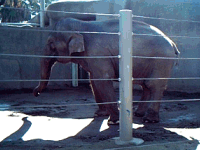
Elephants are also commonly exhibited in zoos and wild animal parks.
Although successful hybridisation between African and Asian Elephant species is highly unlikely in the wild, in 1978, however, at Chester Zoo, an Asian elephant cow gave birth to a hybrid calf sired by an African elephant bull (the old terms are used here as these events pre-date the current classifications). " Motty", the resulting hybrid male calf, had an African elephant's cheeks, their ears (large with pointed lobes) and legs (longer and slimmer), but the toenail numbers, (5 for each front foot, 4 hind) and the single trunk finger of an Asian elephant. His wrinkled trunk was like that of an African elephant. His forehead was sloping with one dome and two smaller domes behind it. The body was African in type, but had an Asian-type centre hump and an African-type rear hump. The calf died of infection 12 days later. It is preserved as a mounted specimen at the British Natural History Museum, London. There are unconfirmed rumours of three other hybrid elephants born in zoos or circuses; all are said to have been deformed and none survived.
Criticism
There is growing resistance against the capture, confinement, and use of wild elephants. Animal rights advocates allege that elephants in zoos "suffer a life of chronic physical ailments, social deprivation, emotional starvation, and premature death". However, zoos argue that standards for treatment of elephants are extremely high and that minimum requirements for such things as minimum space requirements, enclosure design, nutrition, reproduction, enrichment and veterinary care are set to ensure the wellbeing of elephants in captivity.
Elephants in culture
The elephant has been an icon for humanity for thousands of years, appearing in cultures across Europe, Asia, Africa and the Americas. There are references of elephant throughout popular culture, religion, philosophy, politics and secular symbolism.
Popular culture
- For example, the expression white elephant refers to an expensive burden, particularly to a situation in which much has been invested with false expectations. The phrase 'white elephant sale' was sometimes used in Australia as a synonym for jumble sale. Jumbo, a circus elephant, has entered the English language as a synonym for "large".
- Some elephants in Thailand have been trained to paint self portraits.
Religion and philosophy
- A white elephant is considered holy in Thailand.
- Elephants are used in festivals in Sri Lanka, such as the Esala Perahera.
- Ganesh, the Hindu god of wisdom, has an elephant's head.
- The scattered skulls of prehistoric pygmy elephants on Crete, featuring a single large nasal cavity at the front, may have formed the basis of belief in existence of cyclops, the one-eyed giants featured in Homer's Odyssey.
Politics and secular symbolism
- After Alexander's victory over the Indian king Porus, the captured war elephants became a symbol of imperial power, used as an emblem of the Seleucid diadoch empire, e.g. on coins.
- The elephant, and the white elephant (also a religious symbol of Buddha) in particular, has often been used as a symbol of royal power and prestige in Asia; occurring on the flag of the kingdom Laos (three visible, supporting an umbrella, another symbol of royal power) till it became a republic in 1975, and other Indochinese and Thai realms had also displayed one or more white elephants.
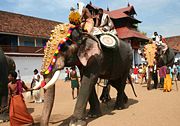
Elephant rage
Despite its popularity in zoos, and cuddly portrayal as gentle giants in fiction, Elephants are among the world's most potentially dangerous animals. They are capable of crushing and killing any other land animal, even the rhinoceros. They can experience unexpected bouts of rage, and can be vindictive. In Africa, groups of young teenage elephants attack human villages in what is thought to be revenge for the destruction of their society by massive cullings done in the 1970s and 80s. In India, male elephants attack villages at night, destroying homes and killing people on a regular basis. In the Indian state of Jharkhand, 300 people were killed by elephants between 2000 and 2004, and in Assam, 239 people have been killed by elephants since 2001. In India alone there are up to 200 elephant-caused human deaths every year, and in Sri Lanka around 50 per year.
Musth
Adult male elephants naturally enter the periodic state called musth (Hindi for madness), sometimes spelt "must" in English. Musth behaviour is at least partly due to the elephant being driven mad by pain and distress. It is characterised by very excited and/or aggressive behaviour and a thick, tar-like liquid secretion that discharges through the temporal ducts from the temporal glands on the sides of the head. The musth secretion, which naturally runs down into the elephant's mouth, is full of ketones and aldehydes and (to a human at least) tastes unbelievably foul. The swelling of the temporal glands presses on the elephant's eyes and causes the elephant severe pain comparable to severe root abscess toothache. One elephant behaviour to try to counteract this is to dig its tusks into the ground.
Musth is linked to sexual arousal or establishing dominance, but this relationship is far from clear. Numerous cases of elephant goring and killing of rhinoceroses in national parks in Africa have been documented and attributed to musth in young male elephants, especially those growing in the absence of older males. Studies show that reintroducing older males into the population seem to have the effect of preventing younger males from entering musth, and therefore, stopping their aggressive behaviour.
A musth elephant, wild or domesticated, is extremely dangerous to humans. Domesticated elephants in India are traditionally tied to a tree and denied food and water for several days, after which the musth passes. In zoos, musth is often the cause of fatal accidents to elephant keepers. Zoos keeping adult male elephants need extremely secure enclosures, which greatly complicates the attempts to breed elephants in zoos.
Musth is accompanied by a significant rise in reproductive hormones. Testosterone levels in an elephant in musth can be as much as 60 times greater than in the same elephant at other times. However, whether this hormonal surge is the sole cause of musth, or merely a contributing factor is unknown: scientific investigation of musth is greatly hindered by the fact that even the most otherwise placid of elephants may actively try to kill any and all humans. Similarly, the tar-like secretion remains largely uncharacterised, due to the difficulties of collecting a sample for analysis.
Although it has often been speculated that musth is linked to rut, this is unlikely, because the female elephant's estrus cycle is not seasonally-linked. Furthermore, bulls in musth have often been known to attack female elephants, regardless of whether or not the females are in heat.
Other causes
At least a few elephants have been suspected to be drunk during their attacks. In December 1998, a herd of elephants overran a village in India. Although locals reported that nearby elephants had recently been observed drinking beer which rendered them "unpredictable", officials considered it the least likely explanation for the attack. An attack on another Indian village occurred in October 1999, and again locals believed the reason was drunkenness, but the theory was not widely accepted. Purportedly drunk elephants raided yet another Indian village again on December 2002, killing six people, which led to killing of about 200 elephants by locals.
Family classification
See Elephant classification

